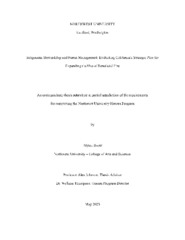| dc.contributor.advisor | Johnson, Alex | en |
| dc.contributor.advisor | Thompson, William | en |
| dc.contributor.author | Snow, Alyssa | en |
| dc.date.accessioned | 2023-06-09T21:44:26Z | |
| dc.date.available | 2023-06-09T21:44:26Z | |
| dc.date.issued | 2023-05 | en |
| dc.identifier.uri | archives.northwestu.edu/handle/nu/61664 | |
| dc.description | An undergraduate thesis submitted in partial satisfaction of the requirements for completing the Northwest University Honors Program. | en |
| dc.description.abstract | In recent years, wildfires of increased frequency, magnitude, and destruction have plagued California, risking lives, property, and ecosystem health. The development of intensifying fire conditions can be traced through the history of California statehood, with Euro-American fire suppression techniques replacing the prescribed burning and traditional ecological knowledge used by Indigenous people to steward ecosystems. Despite waning fire resilience and biodiversity, California fire policy remained staunchly in favor of fire suppression outside of limited allowances for government-led prescribed burns, enforcing legal barriers to Indigenous stewardship and cultural burns through the 21st century. However, recent wildfire destruction prompted the 2022 “California’s Strategic Plan for Expanding the Use of Beneficial Fire” (“Strategic Plan”), which reversed longstanding suppression-dominated fire management and sought to include Indigenous and non-government practitioners as partners in implementing prescribed burns across California. Although the “Strategic Plan” incites drastic changes, a comparison between the “Strategic Plan” and “Good Fire: Current Barriers to the Expansion of Cultural Burning and Prescribed Fire in California and Recommended Solutions” reveals detrimental oversights. The state government’s failure to create policies ensuring ethical partnership with Indigenous people and repeal policies hindering non-government participation impairs the ability of the “Strategic Plan” to guide extensive utilization of prescribed fire. | en |
| dc.description.tableofcontents | Abstract, p. 1 -- Introduction, p. 2 -- Literature review, p.3 -- Methodology, p. 16 -- Results, p. 17 -- Discussion, p.28 -- Conclusion, p. 31 -- References, p. 33 | en |
| dc.format.extent | 36 pages | en |
| dc.format.medium | PDF | en |
| dc.language.iso | en | en |
| dc.publisher | Northwest University | en |
| dc.rights | This original work is protected by copyright. Copyright is retained by the author(s). Works may be viewed, downloaded, or printed, but not reproduced or distributed without author(s) permission. | |
| dc.rights.uri | http://archives.northwestu.edu/page/copyright | |
| dc.subject | Wilfires | en |
| dc.subject | Environmental policy | en |
| dc.subject | Environmental protection | en |
| dc.subject | California | en |
| dc.title | Indigenous Stewardship and Forest Management: Evaluating California's Strategic Plan for Expanding the Use of Beneficial Fire | en |
| thesis.degree.level | Undergraduate | en |
| thesis.degree.grantor | Northwest University | en |
| thesis.degree.discipline | College of Arts and Sciences | en |


 Maintained by the Northwest University Library
Maintained by the Northwest University Library